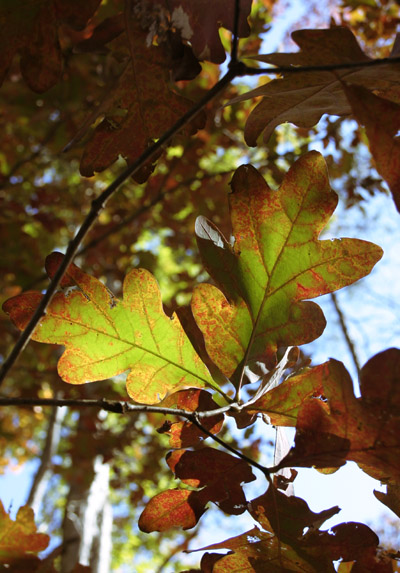
While I have unfortunately been unable to get out and do justice to the autumn season around here, I feel obligated to at least get a few examples up. The biggest issue I have right now is with trying to get my digital images to adequately represent the colors that I’m actually seeing. The sky in particular has been remarkably clear and rich in color, but the digital camera simply isn’t capturing the right range of color, and this requires a bit of tweaking to try and correct.
Conditions like this cry out for slide films like Fuji Provia and Velvia, which provide deep contrast and vivid colors where digital has a tendency to wash out and either overexpose or lose saturation in certain color registers. But it takes a while for slide films to get back, and I’m planning to do a proper film session shortly, with both 35mm and 645 in a setting that begs the attention, so right now we’ll go with what I have from the past couple of days.
 For some reason, this area is prone to leaf damage, blights or insect infestations or whatever, and finding a few nice, shapely leaves without spots and holes is actually challenging. Anytime from late spring on means I’m often being very selective about what foliage I use as a subject or background, because even out of focus, the subtle message is one of disease or trouble.
For some reason, this area is prone to leaf damage, blights or insect infestations or whatever, and finding a few nice, shapely leaves without spots and holes is actually challenging. Anytime from late spring on means I’m often being very selective about what foliage I use as a subject or background, because even out of focus, the subtle message is one of disease or trouble.
The color is an interesting trait by itself. There’s a theory being examined right now that says the red color of many species is a warning to predatory insects like aphids, allowing the trees to retain more of their nutrients heading into winter. The dominance of red colors among North American trees, as opposed to the yellows of Europe, may stem from the terrain in the different areas and the advancement of the glaciers. The big mountain ranges in North America, such as the Rockies and the nearby Appalachians, run north-south, which allowed herbivorous insects to migrate southward as the glaciers advanced down from the northern climes. In Europe, however, the mountains run east-west and formed an impassable barrier to insects as the glaciers came down, wiping out many species. So the trees in Europe did not develop the specialized resistance to insects over the time periods that the North American trees did, since those withstood the predation over a much longer period and had more chance to develop protective traits.
We’ve actually been a bit luckier this year, in that the typical fall storms and winds have been largely absent, so the trees are retaining their colors much longer – last year a gusty storm rolled through right at peak color and swept much of the foliage from the trees, trashing the plans I had to capture the colors. I can’t speak for other nature photographers, but I’ve spent many years making plans and having to change them for one condition or another, and that’s simply how it goes. You can’t predict, you can only go with the flow.





















































